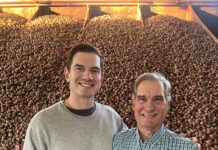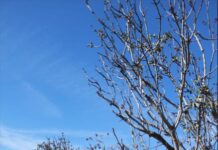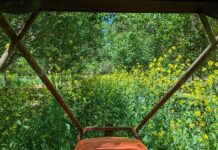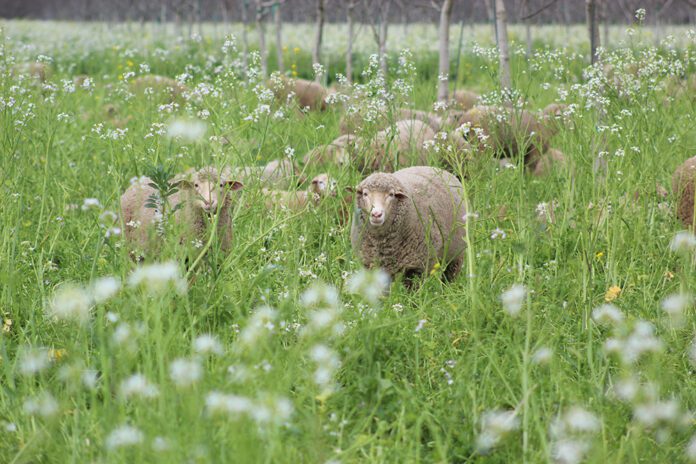
At Machado Family Farms in Linden, Calif., Drew Cheney is managing his wife’s family’s fourth-generation farm, combining tradition with innovation by using cover crops and sheep grazing in their walnut orchards.
The diversified farm produces walnuts, almonds, cherries and young table olives. The operation began grazing sheep in the orchards four years ago, starting with 800 head. That number has since grown to 3,000.
“As long as they’re not going to attack the bark, I try to get sheep in the orchards,” Cheney said. “The shepherds are amazing, and I love having the sheep on here.”
Vince Arburua of VA Livestock and his brother Frankie of F Ewe Sheep Company provide the sheep. Cheney said the partnership has become a key component of his orchard management strategy, with the Arburua brothers supplying well-managed flocks accustomed to grazing cover crops in permanent crops. Their consistent communication and mutual understanding have helped the collaboration run smoothly, benefiting both soil health and livestock performance.
“They know what they have to do with the sheep, and I know what I have to do in the orchard,” Cheney said. “Unless we talk about it, we could step on each other’s toes.”
The integration of sheep grazing has helped reduce inputs across the farm. Cheney noted a decrease in water use, mowing passes, spray applications and, depending on nutrient needs verified through testing, said he’s reducing fertilizer by 25% per year.
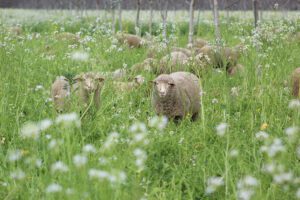
Alongside reduced input costs, Cheney said he’s seen meaningful improvements in soil health. Cover cropping and grazing have helped increase organic matter and improve water infiltration, making his soils more resilient in both wet and dry years.
“We’re seeing better structure and less compaction in the blocks that have had sheep the longest,” he said.
The cover crops provide prime grazing for the sheep as well.
“Because I put in a very diverse, healthy cover crop mix that was designed specifically for grazing, they bring their ewes on that are about to give birth to lambs,” he said. “When the ewes give birth, they recover faster, they gain their weight back faster while they’re nursing, and the lambs gain faster as well.”
As food safety remains a top priority, particularly under the Food Safety Modernization Act, which requires a 120-day preharvest interval for animal activity in tree nut orchards, Cheney said he maintains detailed records and has even conducted his own testing to ensure compliance.
“If I’m not comfortable feeding something to my child, I’m not going to ship it out and expect someone else to eat it,” he said.
Cheney said he personally collected a gallon-sized freezer bag of fresh sheep manure and had it tested by a local lab for E. coli O157, listeria and salmonella. The samples came back clean, with zero hits for two consecutive years, reinforcing his confidence in the health of the sheep and the safety of his orchard practices.
Handlers Taking a Closer Look
The grazing approach has caught the attention of walnut handlers, who are increasingly aware of consumer interest in sustainably produced food.
“Handlers are looking at this, they’re interested, but the onus is on the grower’s shoulders to make sure that their product is 100% safe when they send it out,” Cheney said. “They’re working with me to see if there’s a way we can create a system at the huller that would still make consumers feel confident and comfortable and allow growers to graze sheep in the orchards for longer.”
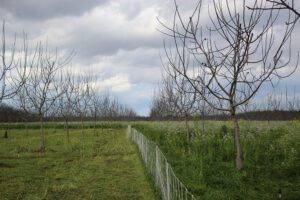
He hopes to begin collecting measurable data this season to support broader adoption of the practice.
“If we can develop actual quantifiable data that handlers can use, I think we can expand this,” Cheney said.
Still, he acknowledged the practice isn’t without its challenges. Managing logistics, coordinating with shepherds and ensuring strict compliance with food safety regulations all take planning and communication.
But ultimately, he believes sustainable practices like these are one piece of a larger goal.
“There’s definitely more work involved on the front end,” he said, “but once you build that system, it really starts to work for you.”

Kristin Platts | Digital Content Editor and Social Correspondence
Kristin Platts is a multimedia journalist and digital content writer with a B.A. in Creative Media from California State University, Stanislaus. She produces stories on California agriculture through video, podcasts, and digital articles, and provides in-depth reporting on tree nuts, pest management, and crop production for West Coast Nut magazine. Based in Modesto, California, Kristin is passionate about sharing field-driven insights and connecting growers with trusted information.







